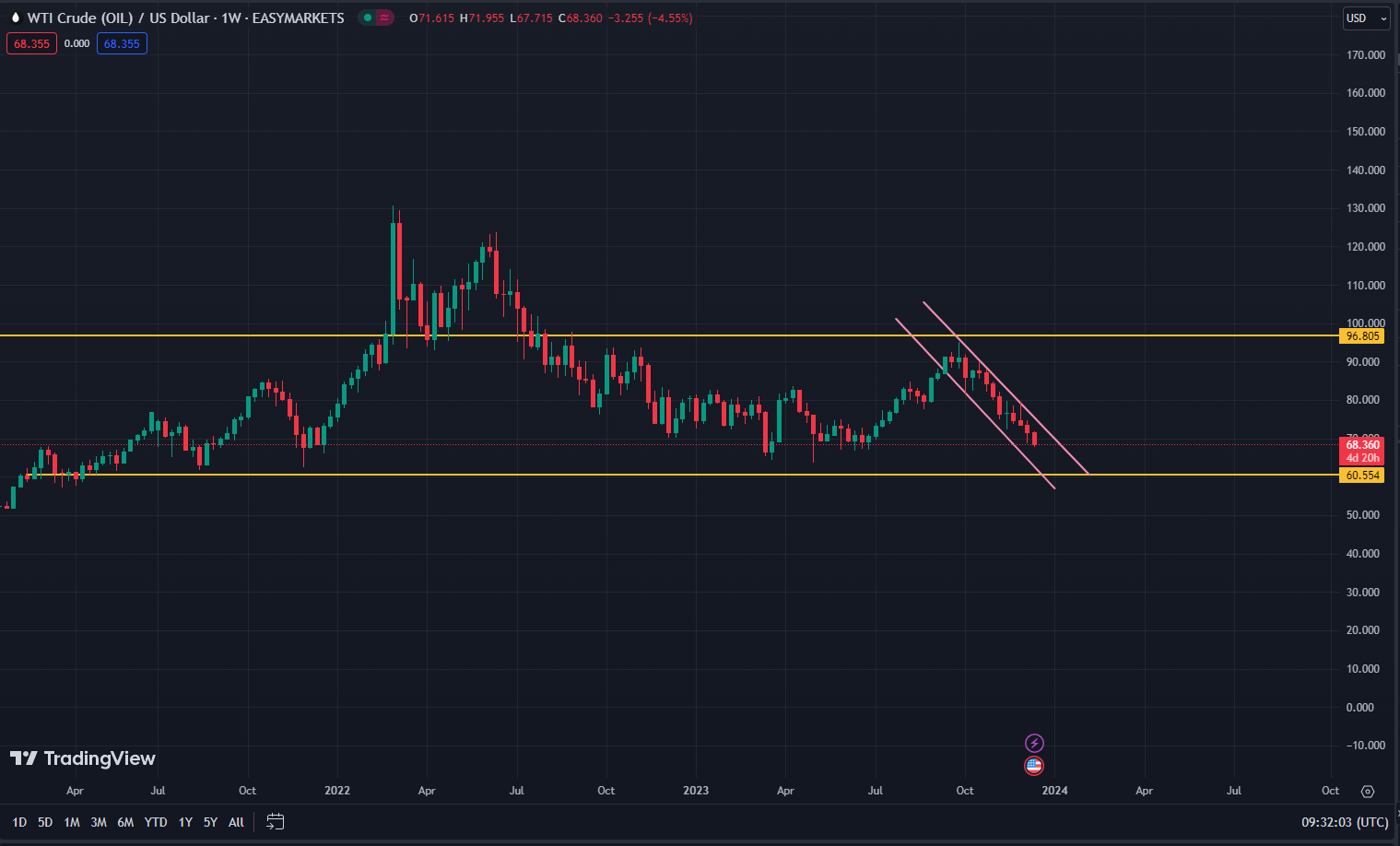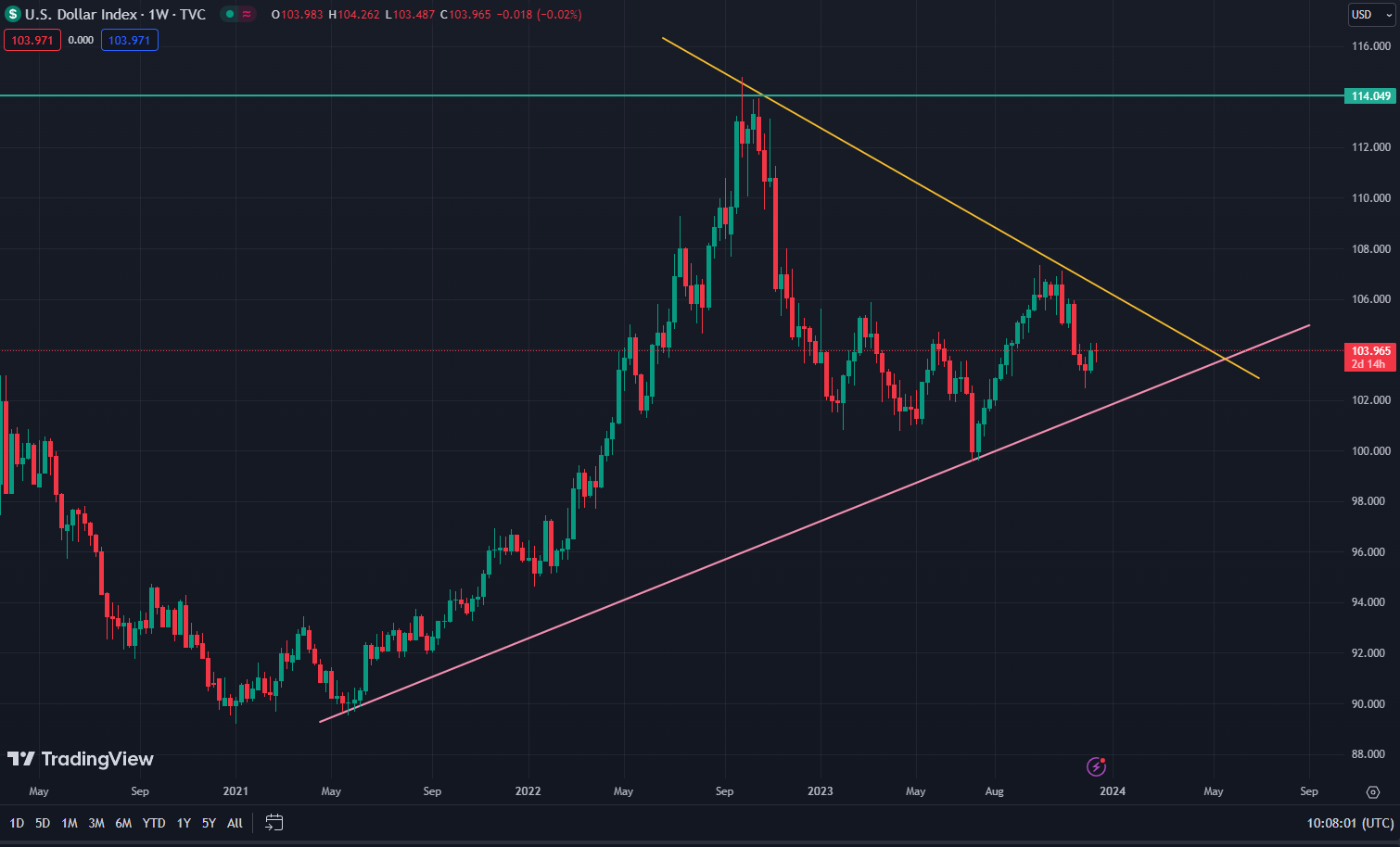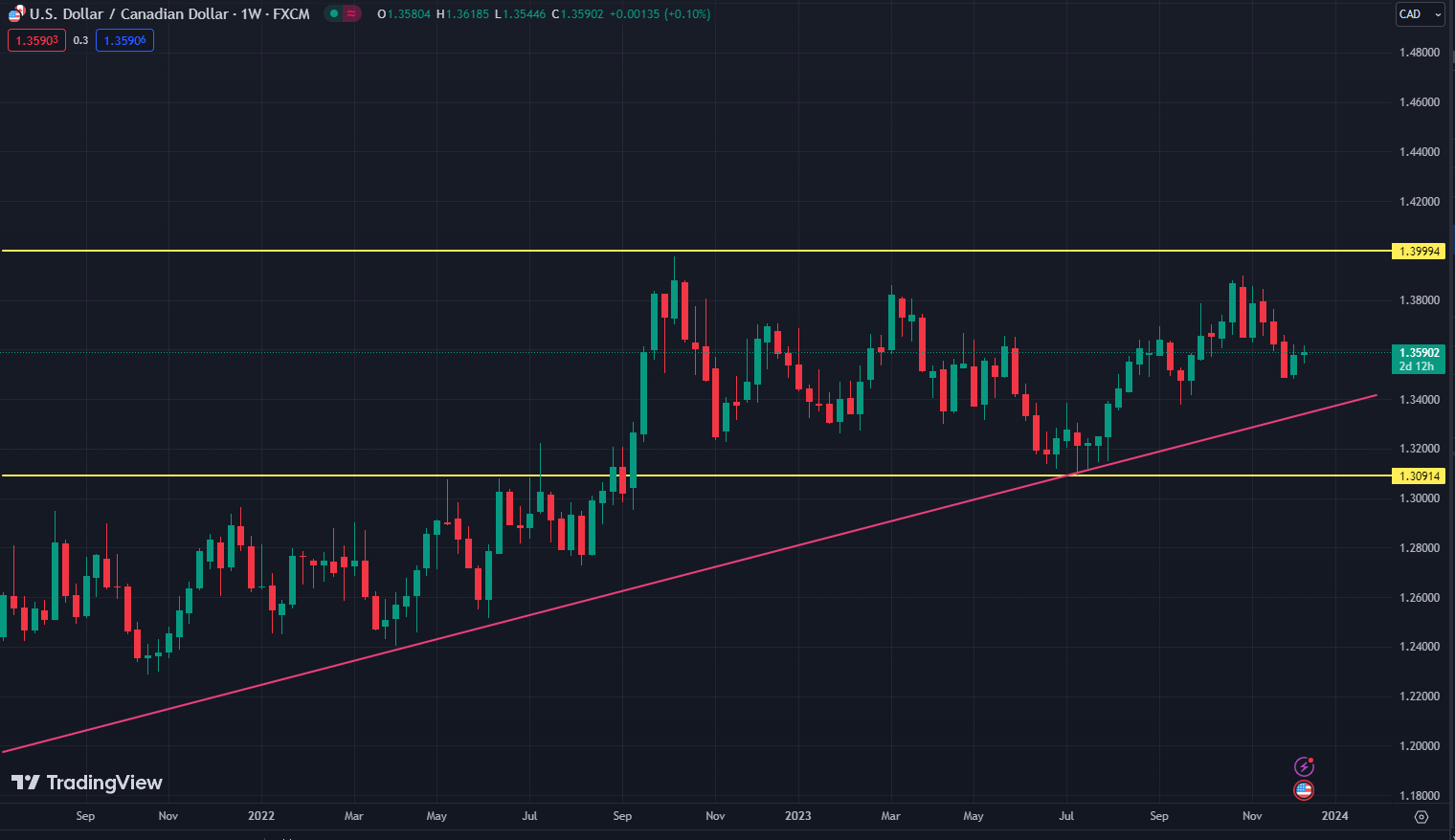USD/CAD FX Rate Prediction for 2024

The US Dollar against the Canadian Dollar (USD/CAD) is one of the most traded currencies in the Forex market. The USD/CAD pair belongs to the “majors” group, and attracts investors and traders from all over the world.
Historically, the US Dollar has been stronger than the Canadian one. However, it’s worth mentioning that on September 20, 2007, the Canadian dollar reached parity of 1:1 with the USD for the first time in 31 years. Since then, each currency experienced fluctuations in their value.
The USD/CAD pair is often referred to as a commodity pair, as Canada is one of the major exporters of Oil and the United States of America is the largest consumer. Changes in Oil prices can significantly impact the Canadian dollar value. However, there are many other factors that influence the currency markets.
Forecasting currency prices is like piecing together an intricate puzzle with millions of components, requiring a thoughtful estimation based on available information. While there’s no guarantee of absolute precision in these predictions, it’s important to delve deep into market insights to make well-informed decisions. Whether you’re an active trader or just someone who regularly uses the Canadian Dollar in day-to-day transactions and is curious about its future value against the USD in 2024, this article is tailored for you. Join us as we unravel the complexities of currency forecasting and explore strategies to navigate the dynamic world of financial markets.
Factors that influence the USD value
The US Dollar is a global currency and there are numerous factors that impact its value. USD is accepted throughout the entire world because investors see it as a stable currency. However, there are many countries that try to change the Dollar’s dominance as the world’s major currency. Particularly China, and BRICS (Brazil, Russia, India, China, and South Africa), are trying to create and use their own currencies in global trade. It’s worth mentioning that their efforts to rival the USD have been unsuccessful in the past and are most likely to fail in the future. The US Dollar is more impacted by the technical and fundamental factors than by the competitor currencies. Let’s discuss these factors in more detail.
Interest Rates
Interest rates play an important role in the value creation for certain currencies. Increasing or decreasing the rates gives the central banks the most effective tool to manage inflation. The central bank of the USA is the Federal Reserve, and its main purpose is to protect Americans from high inflation and keep the rates stable to help the economy grow. High interest rates are dangerous for the economy as it limits access to money for individuals and businesses. For this very reason, central banks only increase rates when they have to.
For the past few years, in an attempt to fight inflation, the Federal Reserve has increased interest rates starting from 0.25% at the end of 2021, to 5.5% at the end of 2023. Higher interest rates simply means that bank loans become more expensive for regular Americans and as a result, less and less people will take out loans. Less money circulated in the economy, the stronger the currency. The Supply and demand principles in price creation is also true for the interest rates and their impact. Strict monetary policy from the central bank is likely to continue through 2024 to fight inflation.
Economic Indicators
There are various economic indicators that we need to consider in determining the strength of the US Dollar in 2024. Firstly, it’s important to look at the GDP (Gross Domestic Product). Stronger the US economy, stronger the US Dollar can be. It should be mentioned that the United States remains the world’s most prosperous economy with over 25 Trillion US Dollars in GDP. Throughout 2023, the US monthly GDP was ranging between 2% and 3.2%. However, at the end of the year, particularly in November, GDP was 5.2%. It is likely that this tendency will continue and the US economy will grow between 2-4% in 2024.
The United States has a strong economy with a low unemployment rate. In November 2023, the national unemployment number was at 3.7%
Inflation Rates
High inflation is bad for the economy and can have an impact on USD/CAD value. High inflation means that the currency loses its purchasing power, making it less attractive for the investors. In addition, when the US Dollar experiences high inflation, the central bank has to intervene and increase rates, which ultimately leads to weakened economic growth. In 2022, the US economy experienced high inflation, however, the inflation rate is being stabilized gradually and is projected to be stable in 2024. Let’s take a look at the US inflation rate for the past two years.
| Year | Jan | Feb | Mar | Apr | May | Jun | Jul | Aug | Sep | Oct | Nov | Dec |
|---|---|---|---|---|---|---|---|---|---|---|---|---|
| 2023 | 6.4 | 6.0 | 5.0 | 4.9 | 4.0 | 3.0 | 3.2 | 3.7 | 3.7 | 3.2 | 3.1 | N/A |
| 2022 | 7.5 | 7.9 | 8.5 | 8.3 | 8.6 | 9.1 | 8.5 | 8.3 | 8.2 | 7.7 | 7.1 | 6.5 |
Trade Balances
Trade balance is an important determinant of the strength of a local currency. In simple words, if more goods are sold in foreign countries than bought (trade balance is positive), it means that more currency is injected into the local economy and its products are in demand globally. And when there’s a negative balance, it means that more currency is leaving the country, which can become a problem. However, let’s not forget that the US Dollar is an international currency and when the government starts running out of money to spend, it can simply print more dollars. Which actually is happening, and the US debt widens each year.
The US trade deficit has been steadily increasing for the past few years and in 2022, the deficit has reached a record number of 945.32 billion U.S. dollars. We do not have 2023 data yet, but it’s likely that the trade deficit will be high. In contrast, the deficit was 393.77 billion USD in 2009 and it was 446.86 in 2013. The increasing trade deficit is bad for the US economy and therefore, can damage the value of the US Dollar.
Government Debt
As mentioned above, the US Debt is increasing, which is bad for the US Dollars strengths, because to pay to the lenders, the government practices taking more loans and increasing the money supply. Increased money supply means that the value of individual dollars will be weaker. Currently the US gross federal debt is over 33 trillion US Dollars, which is a much higher amount than the country’s entire GDP (25 Trillion USD). The $33 trillion gross federal debt equals debt held by the public plus debt held by federal trust funds and other government accounts.
Political Stability and Economic Performance
2024 is an election year in the United States, and the election campaigns can have a significant impact on the value of the US Dollar. Investors from all over the world are closely monitoring US internal politics and making their decision on whether to invest in the Dollar or not. Historically, democrats are advocating for policies that prioritize employment and equality and increase social spending that makes national currency weaker. Increased government spending is a bad creator of real jobs. And fake jobs do not create products. Republicans on the other hand, prioritize policies that lead to lowered inflation and limited spending. However, the policies also largely depend on the stance of presidential candidates. From today’s perspective, as we are at the start of 2024, it is uncertain how the election will impact the US Dollar.
Global Economic Conditions
Let’s not forget that the two America’s allies: Ukraine and Israel are actively involved in the military conflicts, and the US government spends billions of US taxpayers’ money to help its friends. However, the increased spending leads to a weaker dollar. And it is likely that the military conflicts will continue in 2024.
Factors that influence the Canadian Dollar value
As already mentioned, the Canadian Dollar is mainly influenced by the global oil price, however, there are many other factors that have their impact on the currency’s value. Let’s delve into more details.
Interest Rates
Similarly to the Federal reserve, Canada’s Central Bank gradually increased the interest rates to counter the inflation. Rates started increasing from 0.25% at the beginning of 2022, and increased to 5% by 2023. It is likely that the high rates will remain for 2024. High interest rates have a positive short term impact on currency value, however, high rates are damaging in the long run because they hurt the economy. Regular people find it difficult to take out loans, spending is decreased, businesses suffer and the economy shrinks.
Economic Indicators
Canada has one of the strongest economies in the world with over 2 trillion dollars in GDP. In 2022, Canada had a GDP of 2,139,840. However, the growth rate is highly volatile, for instance, in 2019, the growth rate was 1.9%, in 2020 it was -5.1%, and in 2021 the rate was 5%. In 2022, Canada’s economy grew by 3.4%
Inflation Rates
The inflation rate in Canada is also highly volatile. There are years with super low inflation, and years when the inflation is skyrocketing. Let’s take a look at the inflation chart for the past several years.
| 1.6% | 2.27% | 1.95% | 0.72% | 3.4% | 6.8% | 3.62% (estimated) |
|---|---|---|---|---|---|---|
| 2017 | 2018 | 2019 | 2020 | 2021 | 2022 | 2023 |
Trade Balances
Canada has generally had a trade surplus in natural resources and commodities mainly such as Oil and natural gas, but a trade deficit in manufacturing goods. The Canadian trade balance has seen notable fluctuations in recent years. In 2022, Canada achieved a trade surplus of $3.73 billion, a significant improvement from the deficit of $0.83 billion in 2021. In 2020, the trade balance showed a deficit of $36.91 billion, while in 2019, it was $25.56 billion in the negative. The fluctuations in trade balance is largely linked to the price of energy, mainly oil.
Canada’s Debt
Canada’s national government debt increased significantly for the past few years. Increased debt is bad for the economy and can damage the value of Canadian Dollar, as serving the debt might mean that the government prints more money and consequently weakens the currency. Let’s take a look at the debt chart over the past years.
| 0.887 Trillion | 0.884 Trillion | 1.314 Trillion | 1.473 Trillion |
|---|---|---|---|
| 2019 | 2020 | 2021 | 2022 |
Oil price prediction for 2024
The Canadian Dollar is heavily impacted by the price of oil as the country’s budget largely depends on the oil revenues. The oil industry is one of the largest employers in the country. In addition, the Oil exports benefit the GDP and trade balance numbers. Canada isn’t going to run out of oil any time soon as the country holds the third-largest proven oil reserves in the world. In addition, Canadian companies are also one of the largest natural gas producers.
Oil is a global commodity and its price is generally determined by global supply and demand. Supply is controlled by the major oil producer countries and organizations that include major producers such as OPEC (Organization of the Petroleum Exporting Countries), and OPEC +.
The larger the economy and population, the more oil it consumes. Although steps are taken to replace oil with clean energy and Electric Vehicles (EVs), the battery technology and electricity grids are still not prepared for massive EV adoption. EV sales increase every year, however, oil still remains the dominant source of energy for cars.
Major oil producers are the following countries:
- United States: The USA is one of the largest producers and consumers of oil in the world. Its oil production significantly grew due to the advancements in shale oil extraction technology.
- Saudi Arabia: this country is the leading member of OPEC and one of the world’s largest oil exporters.
- Russia: Russia is one of the largest producers of energy such as natural gas and oil. However, due to its recent war in Ukraine, Russian energy sales have reduced in Europe.
- Canada: as mentioned above, Canada owns huge oil reserves and is one of the major exporters.
- China: China has the second largest population in the world and the country is known as the world’s factory of goods. The country is known for its significant petroleum consumption, however, China is also a notable oil producer.
- Iraq: this country is among top oil producers in the middle east.
The producers play a significant role in determining the price. OPEC and non OPEC countries control prices by regulating the production of the commodity. Some oil producers are interested in high Oil prices, while others have different goals. For instance, western countries are trying to keep oil prices low to limit Russia’s ability to wage war in Ukraine. Saudis and other middle eastern countries are also at high alert due to the military conflicts in Israel. In addition, oil producers understand that too high prices on oil can become an incentive for the world to transition to EVs at even faster rates, which will dramatically impact them in the long run.
If we take a look at the technicals and the WTI Crude oil price chart, we can see that from 2021, the oil price has been mostly ranging between 60 – 100 US Dollars. And currently, the price is in a downward trend. If the downtrend continues and the price breaks the support level, the support can become a resistance and we’ll have low oil prices for 2024. However, it is more likely that the price of oil will remain highly volatile and range between 60-100 USD levels.

Analyzing charts
Technical analysis plays an important role in determining future prices. While it’s true that markets change and study of past performance never guarantees that the future price will be the same. However, it should be noted that studying the past coupled with fundamental analysis can help us make an educated guess.
US Dollar index (DXY)
Analyzing the US Dollar index can give us clues on how strong or weak the USD can be in 2024. In 1973, the United States Federal Reserve introduced the dollar index, designed to monitor the performance of the US Dollar against a basket of six currencies, employing a geometrically weighted methodology, each foreign currency in the index has it’s following weight:
- Euro (EUR) – 57.6%
- Japanese yen (JPY) – 13.6%
- Pound sterling (GBP) – 11.9%
- Canadian dollar (CAD) – 9.1%
- Swedish krona (SEK) – 4.2%
- Swiss franc (CHF)- 3.6%
The index shows that DXY is in an uptrend since the year 2021. Level 100 serves as a support for the index and it is likely that support will keep the price throughout the 2024. Based on the chart, it is likely that the DXY price for the 2024 will be in the range between 100 and 114 levels.

Canadian Dollar Index (CXY)
Similarly to the US Dollar Index, the Canadian Dollar Index represents the weighted average price of a basket of currencies traded against the CAD. Throughout the year 2023, CXY index was traded in a range between 71 and 76 levels. The index price is correlated with the oil price and it’s expected to keep being traded in a range for the year 2024.
US Dollar against the Canadian Dollar (USD/CAD)
USD/CAD currency pair has been in a range for most part of 2023 traded between 1.309 levels and 1.4. If we take a look at the price chart starting from 2022, the price made a little uptrend, and still is in a bit of an uptrend. The 1.309 level was previously a resistance, and after the price broke the resistance, that level became a support. This support was tested in the middle of 2023, and holded the price. In technical analysis, when a resistance becomes a support and vice versa, it is considered a strong level. Therefore, it is likely for the USD/CAD pair to be traded above 1.309 level. However, to predict the resistance level for 2024, it is difficult to solely conduct analysis based on charts as the uptrend dynamic is obvious and the 1.4 level seems to provide a good resistance level. Based on this chart, the USD/CAD price may break the 1.4 level or remain in the range.
Final thoughts
To sum everything up, there are various factors that can impact the value of USD/CAD. Interest rates and inflation have impacted both currencies similarly, and both countries have increased their debt dramatically following the covid-19 pandemic. Price of the Canadian Dollar will be largely impacted by the value of Oil as CAD is a commodity currency pair. In addition, there are factors that can cause unpredictable price movements in the market such as upcoming US elections and its foreign policies. Overall, it’s difficult to speculate where the USD/CAD will be in 2024, but we can make an educated guess that the currency’s value will be ranging between 1.30 and 1.50 levels.



























Comments (0 comment(s))